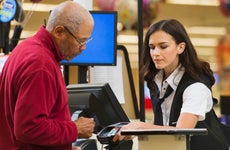Can you buy a money order with your credit card?

The Bankrate promise
At Bankrate we strive to help you make smarter financial decisions. While we adhere to strict , this post may contain references to products from our partners. Here's an explanation for . The content on this page is accurate as of the posting date; however, some of the offers mentioned may have expired. Terms apply to the offers listed on this page. Any opinions, analyses, reviews or recommendations expressed in this article are those of the author’s alone, and have not been reviewed, approved or otherwise endorsed by any card issuer.
Key takeaways
- A money order is similar to a check, except the money for it is taken out of your account at the time of purchase instead of when the recipient cashes it.
- If you want to use your credit card to purchase a money order, you’ll have a difficult time finding a merchant willing to take your card.
- If you have no other choice but to use your credit card, you can go to an ATM, take out a cash advance and use that to pay your money order merchant.
If you need to send cash to someone, a money order is one way to get the job done. A money order is similar to a check, but you pay for it upfront — which means the funds are guaranteed. You make your money order out to a specific individual or business, and they cash it as they would a regular bank check.
Although money orders are less common these days, thanks in part to things like money order scams and the popularity of money transfer apps, people are still sending and receiving money orders through banks and the U.S. Postal Service, as well as services like Western Union and Moneygram and retailers like Walmart and 7-Eleven.
Most issuers only accept cash as payment for money orders, so if you want to use a credit card to purchase a money order, you’ll need to get a cash advance — which can cost you a lot of money in fees and interest charges, especially if you can’t pay off your credit card balance right away. Before you use a credit card to purchase a money order, here’s what you need to know.
How does a money order work?
Although a money order is similar to a regular bank check, it works very differently than a check does. When you write a check from your checking account, the money doesn’t leave your account until the recipient cashes the check. When you purchase a money order, you pay for the entire amount up front, using a guaranteed form of payment such as cash or a transfer from your checking or savings account.
Some people use money orders as opposed to other money transfer methods because they:
- Don’t have a traditional checking account
- Need to make a payment to someone who will not accept a traditional check, credit card or digital transfer
- Want a secure way to send money via mail without their banking information attached
- Want a way to track the money they’re sending to make sure it gets delivered
Money orders also eliminate one of the key risks associated with using bank checks, which is not having enough funds when the check is cashed. When that happens, you’ll incur an overdraft fee, and the recipient may not get their money, which is why some people and organizations hesitate to accept personal checks. With a money order, the recipient knows it’s already paid for, so the money is guaranteed.
Paying for a money order with a credit card
In most cases, you’ll need to use your credit card to withdraw cash from an ATM — a transaction called a cash advance — if you want to use your credit card to fund your money order purchase. Most retailers do not let you use a credit card to pay for a money order directly. If you do find a retailer that lets you buy a money order with a credit card, your credit card issuer will probably still classify the transaction as a cash advance, since you’re essentially purchasing cash.
When you take out a cash advance, your credit card issuer will charge you a cash advance fee on the transaction. That fee is typically a percentage of the total amount with a minimum attached, such as a 5 percent fee with a $10 minimum.
That advance then gets added to your card balance like a purchase, but interest will most likely begin accuring immediately on the cash advance rather than after a grace period as is common with credit card purchases. Furthermore, cash advances typically charge higher annual percentage rates (APRs) than regular purchases; rates can reach 29% or even higher. That means your money order could end up costing you more than you realize.
The best way to avoid the hefty cost of a cash advance is to pay off your cash advance debt immediately — don’t even wait for your statement to close if you can manage it. Letting that debt remain on your credit card for even a few weeks, let alone month after month, will allow interest charges to rack up.
What merchants accept credit cards for a money order?
Currently, no major merchants allow you to pay for a money order with a credit card. Western Union and 7-Eleven are often cited as places that allow customers to pay for a money order with a credit card, but we confirmed directly with both retailers that they only accept cash payments. Walmart, Moneygram and the U.S. Postal Service also do not let people use credit cards to purchase money orders. Some of these places do, however, allow money transfers via credit card by using other methods like telephone transfers — but your issuer will still treat them as a cash advance.
You may be able to purchase your money order with a debit card, since some retailers that do not accept credit cards for money orders will still accept debit.
Can you use a credit card to pay for a money order online?
Money orders must be purchased in person, so you cannot typically use a credit card to pay for a money order online. There are small companies out there that act as middlemen and can print and mail a money order that you’ve paid for on your behalf, but these are few and far between — and they can even be risky to use. To avoid potential scams or issues with your money order, it’s more secure to just purchase one in person — and then keep your receipt until you’re sure it’s been delivered safely.
If you would like to send money to friends or family online instead, consider a money transfer app like Venmo or Square Cash (aka the Cash App). Both apps allow you to use credit cards to make online payments, though you should still watch out for fees — both Venmo and the Cash App charge a 3% fee when you use your credit card to send money, and some credit card issuers code peer-to-peer transactions made with credit cards as cash advances. If you use a debit card or bank account with these apps, you can send money without paying fees.
Can you earn rewards from the purchase of a money order?
Credit card cash advances do not earn rewards — so when you use a credit card to purchase a money order, you will not earn rewards from your purchase.
For example, the Citi Premier® Card (no longer available)— which is one of Bankrate’s top rewards credit cards — earns ThankYou points as part of its rewards program. At the time of writing, the card’s benefit terms and conditions state that “Balance transfers, cash advances, checks that access your Card Account, items returned for credit, unauthorized charges, interest and account fees, traveler’s checks, foreign currency purchases, money orders, wire transfers (and similar cash-like transactions), lottery tickets, gaming chips (and similar betting transactions) do not earn ThankYou Points.”
These types of restrictions are fairly standard among credit card issuers, so you should not expect to earn rewards when you use your credit card for a money order.
What should you do if you need an emergency money order?
If you need an emergency money order, you’ll need to find the closest merchant, retailer or bank that offers money order services. Be aware that although some retailers like Walmart might be open 24 hours a day, the money center within that retailer may operate under limited hours. Contact the merchant or retailer to confirm that their money order services are still open, especially if you need to purchase a money order after standard business hours.
The bottom line
Using your credit card to purchase a money order is not typically possible because money order merchants don’t usually accept credit cards. If you absolutely need to use your credit card and the merchant won’t accept it, then you’ll have to go to an ATM, take out a cash advance yourself, and then use that to purchase the money order. Just be prepared to face high fees and a high cash advance APR for doing so.
For alternative options, consider using a money transfer app or sending a money order with a debit card instead.
Related Articles



